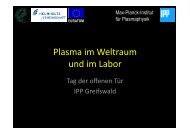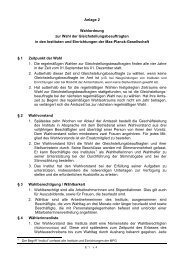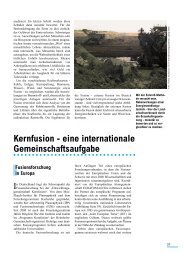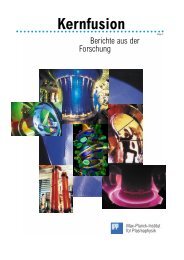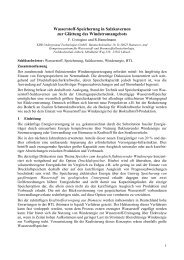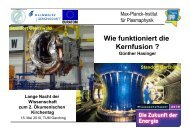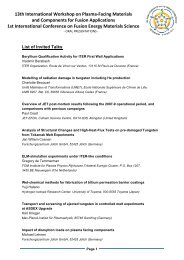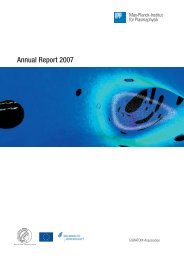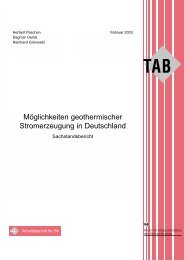Wendelstein 7-X and fusion - Max-Planck-Institut für Plasmaphysik
Wendelstein 7-X and fusion - Max-Planck-Institut für Plasmaphysik
Wendelstein 7-X and fusion - Max-Planck-Institut für Plasmaphysik
Create successful ePaper yourself
Turn your PDF publications into a flip-book with our unique Google optimized e-Paper software.
<strong>Wendelstein</strong> 7-X <strong>and</strong> <strong>fusion</strong><br />
At the cutting edge of technology
At the cutting edge of technology<br />
How can industrial companies benefit from <strong>fusion</strong><br />
research contracts?<br />
Securing reliable energy supplies will remain a major challenge in this century. Currently,<br />
fossil fuel resources (oil, natural gas <strong>and</strong> coal) meet about 90 percent of the worldwide<br />
energy dem<strong>and</strong>. These energy resources are not only being rapidly depleted, but also<br />
cause damage to the environment due to carbon dioxide emissions.<br />
By 2100, the global dem<strong>and</strong> for electricity will probably have increased dramatically by a<br />
factor of six. Thus, in the long term, it is inevitable that the energy supply system will be<br />
restructured.<br />
Since the 1950’s, scientists <strong>and</strong> engineers the world over have been investigating an<br />
alternative source of energy: nuclear <strong>fusion</strong>. Research has been directed towards the<br />
development of a power plant capable of generating energy from the <strong>fusion</strong> of light<br />
atomic nuclei. For this purpose, the fuel (a dilute, ionised hydrogen gas, or plasma) must<br />
be contained in a magnetic field. This plasma must be heated to an ignition temperature<br />
of more than 100 million degrees Celsius <strong>and</strong> the reaction maintained under stable<br />
conditions.<br />
Developing a <strong>fusion</strong> power plant is a technological <strong>and</strong> scientific challenge that has<br />
almost reached the limits of what is achievable technically. In these developments<br />
industrial partners play a key role throughout, both in achieving new heights in<br />
technological excellence <strong>and</strong> in using the acquired know-how to exp<strong>and</strong> their business<br />
into new areas. Fusion research institutions <strong>and</strong> their industrial partners therefore<br />
develop <strong>and</strong> implement together new, innovative solutions on a wide front.<br />
By taking the industrial companies involved in the construction of the <strong>fusion</strong> experiment<br />
<strong>Wendelstein</strong> 7-X as examples, this brochure demonstrates that the partners of <strong>fusion</strong><br />
benefit not only directly from the contracts awarded, but also, <strong>and</strong> sometimes primarily,<br />
from the increase in their expertise <strong>and</strong> from their improved market position.<br />
3
4<br />
Nuclear <strong>fusion</strong> reaction scheme<br />
Proton<br />
Neutron<br />
Deuterium<br />
Tritium<br />
<strong>Wendelstein</strong> 7-X<br />
The <strong>Max</strong> <strong>Planck</strong> <strong>Institut</strong>e for Plasma Physics (IPP) conducts research into the theoretical<br />
<strong>and</strong> physical principles underlying <strong>fusion</strong> power plants. Worldwide, it is the only institute<br />
that investigates both important types of <strong>fusion</strong> device: the tokamak <strong>and</strong> the stellarator.<br />
The ASDEX Upgrade tokamak is in operation in Garching <strong>and</strong> the <strong>Wendelstein</strong> 7-X stellarator<br />
is under construction in Greifswald.<br />
n<br />
Energy<br />
Helium<br />
Hydrogen nuclei fuse in the sun <strong>and</strong> stars under enormous<br />
gravitational pressure. A <strong>fusion</strong> power plant on Earth, however,<br />
must operate on another principle. Under terrestrial conditions<br />
it is the two types of hydrogen, deuterium <strong>and</strong> tritium,<br />
which react most easily. They form a helium nucleus; a neutron<br />
is also released <strong>and</strong> huge amounts of usable energy are<br />
generated. In a power plant, one gram of fuel can generate<br />
90,000 kilowatt-hours of energy. This corresponds to the heat<br />
of combustion of 11 tons of coal.<br />
The optimized <strong>Wendelstein</strong> 7-X device will demonstrate the suitability of the stellarator<br />
device as a power plant. Discharges of up to 30 minutes will demonstrate its essential<br />
property, namely, that of continuous operation.<br />
A key part of the experiment is the coil system, which consists of 50 non-planar <strong>and</strong> 20<br />
planar superconducting magnetic coils. They create magnetic fields, which confine the<br />
hydrogen plasma at temperatures up to 100 million degrees, so that it can be investigated<br />
with various techniques.<br />
In the magnetic coils a superconducting niobium-titanium conductor is used rather than<br />
a normally conducting copper material. During the experiment, liquid helium will flow<br />
through the coils to cool them down to temperatures of approximately -270 degrees<br />
Celsius, close to absolute zero.<br />
Due to this low operating temperature, the coils have been installed in a cryostat that is<br />
made up of a plasma vessel <strong>and</strong> an outer vessel. The vacuum generated between the<br />
two vessels insulates the coils from ambient heat. The plasma can be investigated <strong>and</strong><br />
heated using the 254 ports.<br />
Three different methods are used for heating the plasma: microwave heating with a<br />
power of 10 megawatts, radio wave heating with 4 megawatts <strong>and</strong> neutral beam injection<br />
heating with 20 megawatts.<br />
Companies from all over Europe have worked closely with the <strong>Max</strong> <strong>Planck</strong> <strong>Institut</strong>e for<br />
Plasma Physics in developing <strong>and</strong> manufacturing the <strong>Wendelstein</strong> 7-X device. This process<br />
has given rise to many dem<strong>and</strong>ing challenges <strong>and</strong> provided the participating companies<br />
with valuable technological expertise. The following pages will describe a few of<br />
these achievements.<br />
The five <strong>Wendelstein</strong> 7-X modules rest<br />
on the foundation of the machine.
Five almost identically built modules constitute the <strong>Wendelstein</strong> 7-X device. Each<br />
module consists of a part of the plasma vessel, its thermal insulation, ten superconducting<br />
stellerator coils, <strong>and</strong> four interconnected planar coils, as well as the<br />
pipe system for cooling the coils, a segment of the supporting central ring <strong>and</strong> the<br />
outer vessel.<br />
All five modules have now been positioned on the foundation of the machine.<br />
Considerable work remains to be done until the device goes into operation in the<br />
summer of 2014: The modules need to be welded together; the connections for<br />
heating <strong>and</strong> monitoring the plasma <strong>and</strong> the lining of the plasma vessel must be<br />
mounted. Simultaneously, the heating systems <strong>and</strong> the cooling system that will<br />
supply the coils with liquid helium must be constructed <strong>and</strong> then connected to<br />
the machine. Furthermore, various measuring instruments are being developed<br />
<strong>and</strong> manufactured <strong>and</strong> must be installed.<br />
Graphic depictions of <strong>Wendelstein</strong> 7-X:<br />
plasma vessel, coil support structure with central<br />
ring, outer vessel<br />
The five modules rest on the foundation of the machine<br />
<strong>and</strong> must be connected together<br />
5
6<br />
Large corporations<br />
MAN Diesel & Turbo SE,<br />
located in Deggendorf, Germany<br />
The <strong>Wendelstein</strong> 7-X plasma vessel<br />
“The Mona Lisa of the art of welding” *<br />
Welding the <strong>Wendelstein</strong> 7-X plasma vessel<br />
* Der Spiegel 1/2009 (a German news magazine)<br />
The plasma vessel for the <strong>Wendelstein</strong> 7-X <strong>fusion</strong> experiment, which looks like a woundup<br />
steel tube, is designed to accommodate a hydrogen plasma at roughly 100 million degrees.<br />
The almost ring-shaped plasma chamber has an outer diameter of 12.8 metres <strong>and</strong><br />
a height of 2.5 metres. The steel vessel must match precisely the symmetry of the magnetic<br />
field which confines the hot plasma. The requirements placed on the steel vessel<br />
constructed by MAN Diesel & Turbo thus presented completely new <strong>and</strong> challenging<br />
problems for the company: It was necessary to manufacture an unusually complex, threedimensional<br />
vessel made of stainless steel of volume of 30 cubic metres with a dimensional<br />
tolerance of +/- 2 millimetres. The plasma chamber consists of altogether 200 rings.<br />
Each ring is composed of several 15 centimetre-wide steel strips, which are bent in order<br />
to achieve the required curved geometries. 20 sectors were then fabricated from the<br />
rings using welding techniques suitable for ultrahigh vacuum. The sectors were delivered<br />
to Greifswald where they were welded together onsite, resulting in the complete ring. The<br />
plasma vessel wall has roughly 300 ports of different size, which are necessary for heating<br />
the plasma <strong>and</strong> investigating it scientifically. MAN Diesel & Turbo in Deggendorf was a reliable<br />
partner in fulfilling its contractual obligations.<br />
To successfully complete the project, the Deggendorf factory had to introduce <strong>and</strong> develop<br />
a variety of new technologies.<br />
• Before manufacturing such a complex vessel, detailed computer models had to be developed.<br />
This prompted MAN Diesel & Turbo to introduce the most advanced program<br />
currently available for three-dimensional spatial design. Since then, 3D-spatial design<br />
has become part of the company’s expertise.<br />
• The dimensional accuracy of the vessel had to comply with the highest st<strong>and</strong>ards. For<br />
checking <strong>and</strong> verifying the geometry of the vessel Deggendorf MAN Diesel & Turbo<br />
applied an electronic, laser-assisted surveying system for the first time, which is now<br />
routinely used in all production at the company.<br />
• Manufacturing the steel vessel was the greatest challenge for MAN Diesel & Turbo. The<br />
technology used, in particular the assembly of the vessel using single steel strips derived<br />
from pre-shaped segments, is extremely innovative but requires highly sophisticated<br />
welding techniques in order to prevent the welds from distorting. These technologies<br />
were put to the test in a spectacular way.<br />
• Very precisely positioned steel brackets are required for the installation of the wall elements<br />
inside the plasma chamber. To achieve the accuracy required in a spatially confined<br />
environment, MAN Diesel & Turbo developed a six-axis robotic manipulator that<br />
is now used in the company for various routine applications. Furthermore, the company<br />
used three-dimensional water jet cutting technology to manufacture precisely the 300<br />
openings for the ports.
As a company, MAN Diesel & Turbo has benefited both directly <strong>and</strong> indirectly from<br />
these developments in steel construction. New technologies could be introduced,<br />
which were then improved together with the customer, the <strong>Max</strong> <strong>Planck</strong> <strong>Institut</strong>e for<br />
Plasma Physics. MAN Diesel & Turbo has already applied these new procedures<br />
to manufacture chemical reactors. The engineers <strong>and</strong> technicians – already highly<br />
qualified - were able to increase their expertise <strong>and</strong> promote the competitiveness of<br />
the company.<br />
Liquid helium cools the 70 magnetic coils of the <strong>Wendelstein</strong> 7-X device to -270 degrees,<br />
in order to make them superconducting. Once they have reached this state, the<br />
coils require almost no power. The plasma vessel, the outer vessel, <strong>and</strong> the 254 connecting<br />
pipes, which facilitate access to the plasma vessel, are shielded by the so-called<br />
thermal insulation. This consists of a wrinkled, multi-layer plastic foil coated with aluminium,<br />
which is in contact with an actively cooled shell. The engineers of MAN Diesel<br />
& Turbo in Deggendorf <strong>and</strong> the engineers <strong>and</strong> physicists of the <strong>Max</strong> <strong>Planck</strong> <strong>Institut</strong>e for<br />
Plasma Physics successfully mastered this completely new <strong>and</strong> extremely complicated<br />
engineering problem. Thanks to their close collaboration, they have always found new<br />
solutions to the many engineering problems, <strong>and</strong> in the end produced optimal results.<br />
The thermal insulation of <strong>Wendelstein</strong> 7-X<br />
“Have you ever tried to wrap up a hedgehog?”<br />
Here are a few significant features:<br />
• For the thermal insulation for the plasma vessel, actively cooled elements, which are<br />
called “shields” had to be manufactured. Due to the unconventional shape of the<br />
plasma vessel <strong>and</strong> the extremely confined environment, the precisely shaped shields<br />
had to be made with very high accuracy. Despite advanced shaping technology, attempts<br />
using steel, brass, <strong>and</strong> copper were unsuccessful. The solution was then found<br />
to be a shield made of fibreglass-reinforced plastic.<br />
• Not only did the plastic shields have to be formed exactly to the unusual shape of the<br />
vessel, they also had to be suitable for conducting heat. A technology based on laminated<br />
copper meshes, which has led to a joint patent, proved to be the solution. The<br />
result is a heat-conducting composite that is suitable for use at extremely low temperatures.<br />
• Assembly of the thermal insulation by MAN Diesel & Turbo Deggendorf meant that<br />
the company was taking a risk. Unlike the situation at normal construction sites,<br />
W 7-X represents a complex scientific environment, where the contractor has to<br />
react quickly to adjustments <strong>and</strong> changed requirements. This is typical for a “first of<br />
its kind” facility.<br />
Inner <strong>and</strong> outer view of the <strong>Wendelstein</strong> 7-X<br />
plasma vessel<br />
7
8<br />
Large corporations<br />
Assembly of the thermal insulation for the outer<br />
vessel (brass shields)<br />
Facts:<br />
Research institute:<br />
<strong>Max</strong> <strong>Planck</strong> <strong>Institut</strong>e for Plasma Physics<br />
Industrial Partner:<br />
MAN Diesel & Turbo SE<br />
(Deggendorf, Germany)<br />
Contracts:<br />
Plasma vessel, cryostat, thermal insulation,<br />
wall panels <strong>and</strong> assembly<br />
The manufacturing contract for the thermal insulation caused MAN Diesel & Turbo<br />
Deggendorf to explore a new field of high-tech engineering. With the expert support of<br />
a consultant engineer from Linde AG, MAN has familiarized itself with unknown territory.<br />
In addition to <strong>fusion</strong> devices, cryogenic technology will be applied in the high-energy<br />
accelerators such as the TESLA project currently under construction in Hamburg<br />
<strong>and</strong> the FAIR project in Darmstadt.
Thales Electron Devices, Paris-Velizy, France<br />
Element Six, Great Britain<br />
Diamond Materials GmbH, Reuter Technologie GmbH, Germany<br />
Ignition of a <strong>fusion</strong> reaction requires a heating system suitable for heating the plasma<br />
to 100 million degrees Celsius. Heating with microwaves has been considered a very interesting<br />
option. However, this technology requires the development <strong>and</strong> production of<br />
highly efficient microwave tubes capable of generating 1 million watts. The initial results<br />
were achieved in Russia, the United States <strong>and</strong> Japan a few years ago, when pulses of<br />
only a few seconds duration could be generated. The <strong>Wendelstein</strong> 7-X experiment requires,<br />
however, microwave tubes (or so-called ”gyrotrons”), which are capable of generating<br />
full power for 30 minutes. This is more than one hundred times the duration of the<br />
pulses already achieved <strong>and</strong> meant advancing into an entirely new technological dimension.<br />
This process was pushed forward by the close cooperation between Thales Electron<br />
Devices (TED), the Karlsruhe <strong>Institut</strong>e for Technology <strong>and</strong> the <strong>Max</strong> <strong>Planck</strong> <strong>Institut</strong>e<br />
for Plasma Physics.<br />
• The joint development of the prototype was so successful that the batch production<br />
could be started without delay. However, the consortium was then faced with new<br />
problems that arose during manufacturing, thus creating new technical challenges.<br />
During batch production, the ceramic material used had had to be replaced, which<br />
caused undesirable electromagnetic oscillations in the beam tunnel. To solve this<br />
problem, the Karlsruhe <strong>Institut</strong>e of Technology suggested, <strong>and</strong> patented, a specifically<br />
calculated symmetry perturbation for the beam tunnel. Meanwhile, this solution has<br />
also been proposed for tubes built by Communication & Power Industries (CPI) in the<br />
United States.<br />
• The heat absorbed by the collector material from the electron beam represents an<br />
additional problem. The vacuum could deteriorate due to the high local intermittent<br />
loads. The research institutes involved suggested distributing the heat emission over<br />
a broader area using temporally variable, externally generated magnetic fields. TED<br />
successfully implemented this concept <strong>and</strong> made the breakthrough that improved<br />
the reliability of microwave tubes in continuous operation. A joint patent was issued<br />
for this technology. It can be applied to high-efficiency electron tubes <strong>and</strong> offers significant<br />
potential for improving high efficiency tubes in all fields of application.<br />
• The window between the tube <strong>and</strong> the exterior is another critical component of the<br />
gyrotron. It is made of artificial diamond with a high level of purity to ensure that the<br />
thermal losses will be kept as low a possible. These diamond windows, which have<br />
been manufactured by Diamond Materials in Freiburg <strong>and</strong> Element Six in Engl<strong>and</strong>, in<br />
collaboration with the Karlsruhe <strong>Institut</strong>e <strong>für</strong> Technologie, using the chemical vapour<br />
deposition (CVD) technique, are unique worldwide <strong>and</strong> excellently suited for microwave<br />
<strong>and</strong> millimetre-wave heating applications with their diameters of up to 120 millimetres<br />
<strong>and</strong> thicknesses of 1.8 millimetres.<br />
Heating plasma for <strong>Wendelstein</strong> 7-X<br />
“A diamond window to the plasma”<br />
Thales SA: high-performance microwave tube for<br />
continuous operation<br />
Thales SA: new beam tunnel for the microwave tube<br />
9
10<br />
Large corporations<br />
Reuter Technologie: Soldered diamond window<br />
using the CVD process in a diamond window<br />
• The diamond window requires reliable cooling, but a water-based technique risks corrosion.<br />
For that reason, silicone oil was successfully used as coolant for the first time.<br />
• During their longst<strong>and</strong>ing cooperation, Reuter Technologie <strong>and</strong> the Karlsruhe <strong>Institut</strong>e<br />
for Technology have developed their skills in soldering diamond <strong>and</strong> copper with special<br />
copper-silver-titanium solders. Soldering provides the basis for constructing a diamond<br />
window, which after further soldering is mounted in a stainless steel housing <strong>and</strong><br />
used in a st<strong>and</strong>ard millimetre wavelength transfer line. Soldering together these two<br />
very different materials to produce a vacuum-tight seal represented a special challenge<br />
during the manufacture of the diamond windows with their integrated cooling.<br />
All these improvemements in the concept <strong>and</strong> the technical details have opened up<br />
new ways for manufacturing high-power microwave tubes required in communications<br />
technology, materials technology, the International Thermonuclear Experimental Reactor<br />
(ITER) <strong>fusion</strong> experiment <strong>and</strong> the first <strong>fusion</strong> power plant, “DEMO”. TED, as the<br />
primary contractor, has gained extensive knowledge through the execution of these<br />
contracts <strong>and</strong> is now significantly better positioned in the market. With the acquired<br />
expertise, Diamond Materials <strong>and</strong> Reuter Technologie have also clearly improved their<br />
position for winning future contracts.<br />
Facts:<br />
Research institutes:<br />
Karlsruhe <strong>Institut</strong>e for Technology, <strong>Max</strong> <strong>Planck</strong> <strong>Institut</strong>e for Plasma Physics, Stuttgart University<br />
Industrial partners:<br />
Thales Electron Devices, Microwave Tube Division (Paris-Velizy, France), Diamond Materials<br />
(Freiburg, Germany), Element Six (Ascot, London, Great Britain), Reuter Technologie (Alzenau/<br />
Schöllkrippen, Germany)<br />
Contracts: Eight high-performance gyrotrons, each outputting 1 megawatts for 30 minutes
Plansee SE, Reutte, Austria<br />
The high load <strong>Wendelstein</strong> 7-X wall<br />
„10,000 hotplates on one square metre”<br />
Heating <strong>fusion</strong> plasmas to temperatures of roughly 100 million degrees Celsius requires<br />
very high power outputs in the range of 10 million watts. Although the heated plasma<br />
inside the vessel will be confined by the magnetic field, contact between the plasma<br />
boundary <strong>and</strong> the wall segments cannot be avoided. The temperature of the plasma<br />
decreases dramatically from its centre to its outer boundary where it is “only” about<br />
100,000 degrees Celsius. To protect the wall of the plasma vessel from damage, the<br />
huge heat flow from the plasma has to be conducted through the wall. The sections of<br />
the wall will be protected by water cooled wall elements made of carbon or metal. The<br />
high-performance heat exchangers are known as ”divertors”. Using the <strong>Wendelstein</strong> 7-X<br />
experiment the suitability of stellarators for continuous operation will be tested.<br />
High-performance, water-cooled wall elements<br />
11
12<br />
Large corporations<br />
Target elements during thermographic testing<br />
Facts:<br />
Research institutes:<br />
<strong>Max</strong> <strong>Planck</strong> <strong>Institut</strong>e for Plasma Physics<br />
Industrial partner:<br />
Plansee SE (Reutte, Austria)<br />
Contracts:<br />
Development <strong>and</strong> production of elements<br />
for the first wall, particularly within the field<br />
of divertors<br />
Thus, the development of high-performance divertors has become necessary. Plansee<br />
SE has designed so called “target elements” for the divertors, which must be continuously<br />
capable of withst<strong>and</strong>ing 10 megawatts per square metre. A sophisticated combination<br />
of carbon-fibre-reinforced carbon <strong>and</strong> water-cooled metal blocks, also known as<br />
heat sinks, had to be been developed. Significant steps in this development were made<br />
in close collaboration with the <strong>Max</strong> <strong>Planck</strong> <strong>Institut</strong>e for Plasma Physics.<br />
• Joining the carbon-fibre-reinforced carbon to the water-cooled heat sink made of a<br />
metal alloy has turned out to be extraordinarily dem<strong>and</strong>ing. The carbon is in contact<br />
with the plasma <strong>and</strong> exposed to an extremely high heat load; pressurized cooling water<br />
circulates through the heat sink. For joining the two elements, the carbon had to<br />
be coated with a structured copper layer <strong>and</strong> then welded onto the heat sink to ensure<br />
good thermal conductivity from the surface of the carbon layer to the heat sink.<br />
At the same time, it was necessary to compensate for the different thermal expansion<br />
coefficients of the two materials. Plansee has patented the procedure.<br />
• The water-cooled heat sinks must dissipate tremendous quantities of heat under<br />
conditions of continuous operation. The pressurized cooling water must be circulated<br />
through the body of the metal heat sink. For this purpose, the cooling channel had to<br />
be designed such that turbulent flow occurs <strong>and</strong> more heat is dissipated.<br />
• Quality assurance for this complex structural element composed of several materials<br />
presented a huge challenge for the production of altogether 890 elements,<br />
representing 18,000 tiles. The <strong>Max</strong> <strong>Planck</strong> <strong>Institut</strong>e for Plasma Physics, together with<br />
its contractor Plansee, developed a quality assurance plan based on both systematic<br />
<strong>and</strong> r<strong>and</strong>omized high-performance tests. Because st<strong>and</strong>ard procedures were not<br />
available for non-destructive checking of joints, the company developed special test<br />
methods on the basis of ultrasonic, X-ray <strong>and</strong> thermographic testing.<br />
The heat load of 10 million Watt per square metre mentioned above are higher than that<br />
placed on the edges of the wing of the space shuttle when it re-enters the atmosphere<br />
(6 million watts per square metre), which, however, “only” occurs for several hundred<br />
seconds in that case. Carbon-fibre-reinforced carbon tiles are also used in that application.<br />
Space technology <strong>and</strong> <strong>fusion</strong> technology have been combined for the development<br />
of materials exposed to high temperatures. Under the management of the IPP, an important<br />
joint European project promoted by the EU under the name EXTREMAT (http://<br />
www. Extremat org.) has been carried out. Plansee played a leading role among the 30<br />
project partners, which are predominantly from the industrial sector.<br />
Using a technology that was introduced for the French <strong>fusion</strong> experiment, Tore Supra,<br />
Plansee <strong>and</strong> the <strong>Max</strong> <strong>Planck</strong> <strong>Institut</strong>e for Plasma Physics have refined it for <strong>Wendelstein</strong><br />
7-X <strong>and</strong> improved its quality <strong>and</strong> reliability. These heat-conducting carbon-fibrereinforced<br />
carbon-metal composites are certain to find a wide range of applications.
Plansee SE, Reutte, Austria<br />
Ductile tungsten<br />
“Creative structural materials for high temperatures”<br />
Components for <strong>fusion</strong> must offer high stability under extreme conditions. In particular,<br />
the divertor, which takes up the “helium ash” from the “burning” plasma is exposed to<br />
heat fluxes of 10 megawatts/m 2 or more.<br />
Even those structural components protected behind a heat shield (such as the cooling<br />
channels) may reach operating temperatures exceeding 700°C, <strong>and</strong> therefore need to<br />
have a high resistance to temperature <strong>and</strong> pressure, <strong>and</strong>, at the same time, some degree<br />
of plastic deformability.<br />
Conventional pipes made of heat-resistant materials, such as tungsten, are not suitable<br />
structural materials due to their brittleness.<br />
A completely new heat-resistant material based on tungsten foil has been developed in<br />
collaboration with Plansee. This laminate made of tungsten foil <strong>and</strong> alternating layers of<br />
“soft materials” consists of multiple bonded layers. It can be easily formed into a pipe as<br />
a result of its plastic deformability. Even at high pressures (up to 1,000 bar) <strong>and</strong> ambient<br />
temperatures, the test components did not exhibit fractures <strong>and</strong> remained intact.<br />
The development of deformable tungsten is a promising approach not just for <strong>fusion</strong> research,<br />
but also for many other fields of application.<br />
Plansee, together with the Karlsruhe <strong>Institut</strong>e for Technology, has applied for a patent<br />
<strong>and</strong> hopes to be able to solve future materials problems at high temperatures as the<br />
provider of high-technology materials.<br />
Facts:<br />
Research institute:<br />
Karlsruhe <strong>Institut</strong>e for Technology<br />
Industrial partner:<br />
Plansee SE (Reutte, Austria)<br />
Fractures in brittle, solid tungsten <strong>and</strong> the ductile<br />
behaviour of laminated tungsten notched-bar<br />
impact testing<br />
13
14<br />
Large corporations<br />
Preparation of a non-planar coil for assembling<br />
Babcock Noell GmbH, Würzburg, Germany<br />
The plasma must be held at a temperature of 100 million degrees. Ring-shaped, twisted<br />
magnetic fields confine the plasma <strong>and</strong> thermally isolate it from the cold vessel walls.<br />
The true art now lies in finding the “correct” magnetic field. In stellarator-type <strong>fusion</strong> devices<br />
like <strong>Wendelstein</strong> 7-X, the magnetic field is determined exclusively by the geometry
The superconducting magnetic coils for <strong>Wendelstein</strong> 7-X<br />
“Nature determined the form for us”<br />
of the outer magnetic coils. The complex geometry of the <strong>Wendelstein</strong> 7-X coils is<br />
the result of ten years of systematic calculations using the supercomputers available<br />
in the late 80’s <strong>and</strong> 90’s. Because the shape of the coils is determined by the<br />
physics <strong>and</strong> calculated using strict optimisation procedures, they can be regarded<br />
as ideal. The technical realisation of the coil geometry was extremely challenging<br />
for the contractor. A consortium of companies <strong>and</strong> a European network<br />
involving many sub-contractors for the manufacture of various coil elements had<br />
to be set up. Numerous engineering problems had to be solved:<br />
• In order to manufacture the superconducting, spatially complex winding packages<br />
for the coils, the consortium partners Babcock Noell <strong>and</strong> Ansaldo Superconductors<br />
S.p.A had to develop a special engineering process that would<br />
bring the superconductor into the necessary shape. Suitable winding packages<br />
were built <strong>and</strong> successfully introduced. Moreover, Babcock Noell acquired<br />
valuable experience in the design of steel casings <strong>and</strong> their manufacture using<br />
optimised casting moulds, including the embedding of the winding packages<br />
in the steel casings <strong>and</strong> their high-precision mechanical machining.<br />
• Because they have to withst<strong>and</strong> very high voltages in the event of an emergency<br />
shutdown, the coils must be extremely robust. Each coil had to undergo<br />
a variety of high-voltage tests at up to 13,000 volts. One particularly sensitive<br />
voltage test was conducted in a dilute gas atmosphere. Deficiencies in the coil<br />
insulation caused visible discharges, which could then be rapidly located <strong>and</strong><br />
the corresponding repairs carried out. The test (called a “Paschen Test”) was<br />
developed together with Babcock Noell GmbH as part of the coil testing procedure<br />
in the factory. The extraordinarily strict tests set new st<strong>and</strong>ards for the<br />
quality assurance of superconducting magnets.<br />
The team of Babcock Noell GmbH has demonstrated its remarkable expertise in<br />
the completion of the <strong>Wendelstein</strong> 7-X contract. The know-how has since been<br />
used successfully for other projects <strong>and</strong> for bidding for the manufacturing contract<br />
for the ITER poloidal field coils. W7-X served as an important reference. At<br />
the beginning of 2012, the GSI Hemholtz Centre for Heavy Ion Research awarded<br />
Babcock Noell GmbH a contract for the production <strong>and</strong> delivery of 113 superconducting<br />
magnets for the Facility for Antiproton <strong>and</strong> Ion Research (FAIR)<br />
device in Darmstadt. Ansaldo Superconductors has successfully used the experience<br />
they gained from the W7-X coils in a consortium that has submitted an<br />
application to manufacture the ITER toroidal field coils <strong>and</strong> will manufacture the<br />
European winding packages.<br />
Manufacturing non-planar coils for<br />
<strong>Wendelstein</strong> 7-X<br />
Facts:<br />
Research institutes:<br />
<strong>Max</strong> <strong>Planck</strong> <strong>Institut</strong>e for Plasma Physics, CEA<br />
Commissariat d’ Energie Atomique<br />
(Saclay, France)<br />
Industrial partners:<br />
Babcock Noell GmbH (Würzburg, Germany)<br />
Ansaldo Superconductors S.p.A. (Genoa, Italy)<br />
Contracts:<br />
Fifty superconducting non-planar coils<br />
15
16<br />
Axial High Voltage Divider<br />
“Powerful discharges safely buffered”<br />
Facts:<br />
Research institutes:<br />
Karlsruhe <strong>Institut</strong>e for Technology<br />
Industrial partner:<br />
Babcock Noell GmbH (BNG)<br />
(Würzburg, Germany)<br />
Contracts:<br />
Qualified 5 kV divider after successful<br />
high-voltage <strong>and</strong> material testing<br />
Development of a high-voltage divider for ITER<br />
Babcock Noell GmbH, Würzburg, Germany<br />
The superconducting magnets, which produce the necessary magnetic field for the plasma<br />
confinement in a <strong>fusion</strong> reactor, are cooled to cryogenic temperatures with liquid helium.<br />
The helium flows through metal pipes to the magnets, which are held at high voltage.<br />
In the case of an emergency shutdown, the magnets can generate voltages of up to more<br />
than 10,000 Volt. Therefore, a high-voltage divider must be installed between the metal<br />
feed lines <strong>and</strong> the pipe system.<br />
The high-voltage divider must ensure that the helium lines inside the magnets are electrically<br />
insulated. It has to prevent leaks <strong>and</strong> arcs, which may occur in the event of discharges<br />
<strong>and</strong> arcs inside the magnet, <strong>and</strong> thus help to maintain the necessary helium cooling for<br />
the magnets.<br />
Babcock Noell can now manufacture dividers for different temperature ranges in largescale<br />
production. The efficiency of these dividers has been proven by the Karlsruhe <strong>Institut</strong>e<br />
(KIT) with qualified high-voltage <strong>and</strong> materials tests. The prototypes withstood -196 °C,<br />
70 kV <strong>and</strong> 60,000 cycles undamaged <strong>and</strong> were leak-free. They are thus qualified for ITER.<br />
Babcock Noell can thus provide dividers which set new st<strong>and</strong>ards with regard to vacuum-tightness,<br />
mechanical robustness <strong>and</strong> high-voltage resistance.<br />
These specifications will help to market the dividers not only in the field of <strong>fusion</strong> but<br />
also for the GSI/FAIR project.
Linde AG, Munich, Germany <strong>and</strong><br />
Linde Kryotechnik, Pfungen, Switzerl<strong>and</strong><br />
The <strong>Wendelstein</strong> 7-X magnets must be cooled to a temperature of –270 degrees<br />
Celsius. Conventional superconductivity begins at that temperature, which is less than<br />
four degrees above absolute zero. To accomplish this, liquid helium is pumped into the<br />
space between the wires of the coils. The helium has to be liquefied to the required<br />
temperature using a large refrigeration system. Since this involves a closed-loop cooling<br />
system, the system must be able to react with exceptional flexibility to the various<br />
operational states of the magnets. Linde AG has developed the industrially available<br />
technology significantly further. The flexibility required of the cryogenic system has<br />
been accomplished through the adroit combination of turbines, cooling compressors<br />
<strong>and</strong> cold circulators. A storage tank for the liquid helium makes rapid increases in performance<br />
possible. Overall, the helium refrigeration system at <strong>Wendelstein</strong> 7-X is one<br />
of the most modern <strong>and</strong> flexible systems worldwide.<br />
Linde Kryotechnik was able to develop its expertise in the design <strong>and</strong> construction<br />
of complex large-scale refrigeration systems through the construction of the highly<br />
specialised, highly flexible <strong>Wendelstein</strong> 7-X system <strong>and</strong> thus further qualify itself for<br />
new, major projects.<br />
Refrigeration system for <strong>Wendelstein</strong> 7-X<br />
“Close to absolute zero”<br />
Facts:<br />
Research institute:<br />
<strong>Max</strong> <strong>Planck</strong> <strong>Institut</strong>e for Plasma Physics<br />
Industrial partners:<br />
Linde AG (Munich, Germany) <strong>and</strong><br />
Linde Kryotechnik (Pfungen, Switzerl<strong>and</strong>)<br />
Contracts:<br />
Helium liquefaction system<br />
View into the <strong>Wendelstein</strong> 7-X refrigeration system<br />
17
18<br />
Large corporations<br />
EADS-RST, Rostock, Germany<br />
Development of special mounting equipment<br />
“Six tons positioned with clockwork precision”<br />
Facts:<br />
Research institute:<br />
<strong>Max</strong> <strong>Planck</strong> <strong>Institut</strong>e for Plasma Physics<br />
Industrial partner:<br />
EADS-RST (Rostock, Germany)<br />
Contracts:<br />
Construction, manufacturing <strong>and</strong> set up of<br />
special equipment for mounting at Wendel-<br />
stein 7-X<br />
Robots used to position roughly 6,000 bolts <strong>and</strong> mountings to the inside wall of the plasma vessel.<br />
Assembly equipment, which allows alignment for all six degrees of freedom, is used for<br />
mounting the coils, ports <strong>and</strong> in-vessel components. Such equipment can only be operated<br />
in a restricted way due to the tight space requirements. Moreover, extremely precise specifications<br />
must be taken into consideration. EADS-RST manufactured two manipulators for the<br />
precision positioning <strong>and</strong> alignment of the coils (3.5 metres high <strong>and</strong> 6 tons in weight), an assembly<br />
system that can be rotated <strong>and</strong> positioned precisely, straddling the machine, <strong>and</strong> a<br />
manipulator that takes over the high-precision positioning of installed components in the restricted<br />
space of the plasma vessel using computer control systems.<br />
EADS-RST has developed a complex manipulation technology for the <strong>Max</strong> <strong>Planck</strong> <strong>Institut</strong>e<br />
for Plasma Physics that makes the optimal use of the available space. These h<strong>and</strong>ling systems<br />
are practical, stable <strong>and</strong> achieve a precision of up to 0.5 millimetres. The contracts have<br />
furthered significantly the construction <strong>and</strong> manufacturing expertise of the company, <strong>and</strong><br />
will allow it to become a provider of complex manipulation technology to a greater degree<br />
in future. EADS-RST has acquired detailed know-how on the positioning <strong>and</strong> controlling of<br />
various pieces of precision equipment, which can be used economically with sub-millimeter<br />
precision in the range from a few kilograms to several tons even where access <strong>and</strong> direct observation<br />
are restricted. These insights will extend the service potential of the company for<br />
the development of equipment for customised machine construction. In the meantime, the<br />
company has received requests from other German research institutions for the development<br />
of customised equipment <strong>and</strong> is planning to exp<strong>and</strong> its cooperative efforts in future.
Small <strong>and</strong> medium-sized enterprises<br />
Kraftanlagen Heidelberg GmbH, Germany<br />
The Helium Loop Karlsruhe-Low Pressure system (HELOKA-LP) plays an important<br />
role in the development of the International Fusion Materials Irradiation Facility (IFMIF).<br />
IFMIF is a planned irradiation facility for research into, <strong>and</strong> the licensing of, new materials<br />
that will be used for near-plasma components in the first <strong>fusion</strong> power plant. These<br />
materials must be resistant to the very high temperatures <strong>and</strong> high-energy neutron<br />
flux, which are produced during the <strong>fusion</strong> process. In IFMIF the neutrons are produced<br />
with the help of a particle accelerator. In particular, new types of steel will be tested in<br />
optimised irradiation modules. Equipment that will be developed with HELOKA-LP will<br />
be used for measuring the flow of energy in the helium coolant.<br />
Kraftanlagen Heidelberg GmbH, as general contractor, has solved a number of problems<br />
in the design <strong>and</strong> construction of the HELOKA-LP systems.<br />
• The heating by neutrons naturally occurring in IFMIF will be simulated in the<br />
HELOKA-LP experiments with electrical heating. This system had to be designed<br />
<strong>and</strong> built.<br />
• HELOKA-LP will supply the necessary gas flows. It will include a helium circulatory<br />
system <strong>and</strong> a compressed air line, powered by a helium compressor (350 kilowatts)<br />
<strong>and</strong> an air compressor (500 kilowatts). As a light, mobile gas, working with helium at<br />
the required pressures <strong>and</strong> temperatures is very dem<strong>and</strong>ing.<br />
• In addition, a helium supply system, including a vacuum unit, has been supplied for<br />
the system, in order to guarantee the availability <strong>and</strong> purity of the helium gas. Purity<br />
is an important factor for counteracting corrosion problems.<br />
• Using a complex control system a broad range of operating conditions (pressure,<br />
temperature <strong>and</strong> mass throughput) can be achieved at the entrance of the prototype<br />
irradiation module. The measurement of the cooling efficiency is a necessary<br />
part of the quantitative characterisation of the module. The set-up will be run by a<br />
process control system (Siemens PCS7) allowing fully automatic operation. All test<br />
parameters will be recorded <strong>and</strong> documented during operation by means of a fast<br />
data acquisition system (100 milliseconds) which will also assist the operator with<br />
the analysis of the test sequences.<br />
Helium systems with comparable parameters have not yet been constructed. Thanks<br />
to the collaboration the Karlsruhe <strong>Institut</strong>e for Technology, Kraftanlagen Heidelberg<br />
GmbH has been able to acquire new know-how, <strong>and</strong> is well positioned for participating<br />
in the future IFMIF cooling system <strong>and</strong> additional subsystems (for example, the remote<br />
h<strong>and</strong>ling facility).<br />
HELOKA-LP – testing device for components<br />
for <strong>fusion</strong> research<br />
“Special <strong>fusion</strong> materials require<br />
special test equipment”<br />
The HELOKA test system at the Karlsruhe <strong>Institut</strong>e<br />
for Technology<br />
Facts:<br />
Research institute:<br />
Karlsruhe <strong>Institut</strong>e for Technology<br />
Industrial partner:<br />
Kraftanlagen Heidelberg GmbH<br />
(Heidelberg, Germany)<br />
Contracts:<br />
Complete design <strong>and</strong> construction of the<br />
Helium Loop Karlsruhe (HELOKA-LP)<br />
19
20<br />
Small <strong>and</strong> medium-sized enterprises<br />
Thomson Broadcast, Turgi, Switzerl<strong>and</strong><br />
Development of a high-voltage DC power system<br />
“High tension <strong>and</strong> durability”<br />
Facts:<br />
Research institute:<br />
<strong>Max</strong> <strong>Planck</strong> <strong>Institut</strong>e for Plasma Physics<br />
Industrial partner:<br />
Thomson Broadcast (Turgi, Switzerl<strong>and</strong>)<br />
Contract:<br />
High-voltage DC power system<br />
Switching stage racks for the high-voltage DC<br />
power system<br />
A 130 kilowatt high-voltage DC power supply, with a peak performance of 24 megawatts<br />
in continuous wave operation, has been developed for the various heating systems on<br />
<strong>Wendelstein</strong> 7-X. Above all, this power system must fulfil the high dem<strong>and</strong>s of the microwave<br />
tubes (see above). The normal systems available from Thomson Broadcast had to<br />
be improved in order to reach the necessary specifications. Most importantly, the control<br />
precision has been improved, while increasing the voltage range <strong>and</strong> optimising the<br />
quality of the direct current, in particular reducing the residual ripple.<br />
With the developments described above the Thomson Broadcast high-voltage power<br />
systems are now in a better position on the world market.
Cooling tubes for the components in the plasma vessel<br />
“Steel pipe spaghetti”<br />
Dockweiler AG, Neustadt-Glewe, Germany<br />
A total of four thous<strong>and</strong> five hundred metres of pipes for cooling water will have to be<br />
installed in the plasma vessel of <strong>Wendelstein</strong> 7-X, in order to cool the wall elements exposed<br />
to very high heat fluxes. The complex shape of the plasma vessel determines the<br />
shape of the coolant pipe system, which could only be manufactured with great difficulty<br />
using conventional procedures. Above all, welding the precisely aligned branching<br />
connectors would cost a great deal of time. Dockweiler found a solution. This company<br />
is capable of installing the extrusions or so-called “necks”, at an angle of up to 60°C on<br />
the pipes. To accomplish this, a metal ball is drawn through a hole drilled in the stainless<br />
steel pipe, creating a neck. The connecting pipe can be connected to the finished neck<br />
by means of well-defined <strong>and</strong> highly precise orbital welding techniques.<br />
Dockweiler first began manufacturing three-dimensional pipe systems with the<br />
contract for <strong>Wendelstein</strong> 7-X. The company created their own measurement <strong>and</strong><br />
bending techniques from scratch <strong>and</strong> acquired the corresponding machines,<br />
which will make the manufacturing of even more complicated pipe systems possible<br />
in future. As an additional requirement, Dockweiler had to first master the<br />
special quality requirements of ultra-high vacuum technology. The knowledge<br />
acquired during this process will provide the company access to new fields of<br />
business.<br />
Coolant pipe system for the cryostat (left) <strong>and</strong> the<br />
plasma vessel of <strong>Wendelstein</strong> 7-X<br />
Facts:<br />
Research institute:<br />
<strong>Max</strong> <strong>Planck</strong> <strong>Institut</strong>e for Plasma Physics<br />
Industrial partner:<br />
Dockweiler AG (Neustadt-Glewe, Germany)<br />
Contracts:<br />
Coolant pipe systems for the plasma vessel <strong>and</strong><br />
the cryostat<br />
21
22<br />
Small <strong>and</strong> medium-sized enterprises<br />
CLP, Borgo San Dalmazzo, Italien<br />
Assembling the central ring – “micrometre precision work”<br />
<strong>Wendelstein</strong> 7-X central ring<br />
Facts:<br />
Research institute:<br />
<strong>Max</strong> <strong>Planck</strong> <strong>Institut</strong>e for Plasma Physics<br />
Industrial partner:<br />
CLP (Borgo San Dalmazzo, Italy)<br />
Contracts:<br />
Mechanical assembly of the central ring module<br />
The superconducting magnetic coils for <strong>Wendelstein</strong> 7-X are bolted to a massive central<br />
ring. This steel ring will be subject to forces of roughly 100 tons. For that reason, the<br />
ten individual ring segments have to be positioned with high precision. These steel segments<br />
weighing several tons <strong>and</strong> st<strong>and</strong>ing several metres high were transported to CLP<br />
in northern Italy for the mechanical finishing of the metal surfaces with a precision of<br />
roughly 100 micrometers (100 millionths of a metre) using a milling machine. During the<br />
process, they each had to be re-chucked several times. Special techniques had to be<br />
developed, which could guarantee precise, reproducible positioning despite the size <strong>and</strong><br />
weight. Additionally, the workshops had to be equipped with thermostats to achieve the<br />
required operational precision. To check the precision, computer-controlled measurement<br />
procedures were designed together with CLP <strong>and</strong> successfully implemented. Special<br />
deep drilling techniques were developed for connecting the segments to each other<br />
using long screws made of special steel.<br />
Working on the central <strong>Wendelstein</strong> 7-X ring has opened completely new areas of<br />
work for the company, as well as additional fields for contracts. In accomplishing this,<br />
the company now belongs to the companies qualified for ITER <strong>and</strong> has already received<br />
an ITER contract.
Nordlock AG, St<strong>and</strong>ort St. Gallenkappel, Switzerl<strong>and</strong><br />
The ten individual segments of the central ring described above had to be bolted to<br />
each other. The 70 superconducting coils have also been fastened to the ring using bolt<br />
connections. These guarantee a certain degree of flexibility in comparison with welding.<br />
During the operation of <strong>Wendelstein</strong> 7-X, they will have to bear the heavy loads created<br />
by the magnetic forces, on the one h<strong>and</strong>, <strong>and</strong> by the extremely low temperature of<br />
-270 degrees Celsius, on the other. Nordlock AG provides bolts made of high-strength<br />
Inconel 718 with threads between M20 <strong>and</strong> M90 <strong>and</strong> lengths between 100 <strong>and</strong> 1350 millimetres.<br />
However, the friction co-efficient did not meet the requirements for the assembly<br />
of the components. The higher the friction co-efficient is, the greater the force has to<br />
be holding the bolts in place. For that reason, the company developed a dual phase solid<br />
coating for the bolts. This special development for <strong>Wendelstein</strong> 7-X <strong>and</strong> the simultaneous<br />
usage of silver-coated nuts <strong>and</strong> thrust washers reduced the friction co-efficient to<br />
0.06. Previously, this co-efficient was in the range of 0.12 to 0.14 using special lubricants.<br />
Moreover, the exceptionally low friction co-efficient will remain constant over multiple<br />
clamping procedures, which avoids the need to re-lubricate hundreds of bolts during<br />
possible re-assembly work. The low friction co-efficient also allows the use of smaller<br />
torque wrenches, which simplifies assembly in the very restricted construction space<br />
at <strong>Wendelstein</strong> 7-X.<br />
High levels of tension can be achieved quickly thanks to the ongoing development of<br />
the SUPERBOLT system <strong>and</strong> a new procedure for tightening the nuts. This now belongs<br />
to the st<strong>and</strong>ard procedures at Nordlock AG.<br />
Facts:<br />
Research institute:<br />
<strong>Max</strong> <strong>Planck</strong> <strong>Institut</strong>e for Plasma Physics<br />
Industrial partner:<br />
Ongoing development of<br />
bolt connections<br />
“Bolted, not welded”<br />
Nordlock AG (formerly P&S Vorspannsysteme AG), (St. Gallenkappel, Switzerl<strong>and</strong>)<br />
Contracts:<br />
Further development of the SUPERBOLT system<br />
23
24<br />
Small <strong>and</strong> medium-sized enterprises<br />
Development of an ideal bolometer detector<br />
“Thickly coated platinum”<br />
Optimised bolometer detector using a platinum absorber<br />
for delivery<br />
Plasma lamps during sputter coating<br />
Facts:<br />
Research institute:<br />
<strong>Max</strong> <strong>Planck</strong> <strong>Institut</strong>e for Plasma Physics<br />
Industrial partner:<br />
<strong>Institut</strong> <strong>für</strong> Mikrotechnik Mainz GmbH<br />
(Mainz, Germany)<br />
Contracts:<br />
Development of an optimised bolometer<br />
detector for use in the ITER project<br />
<strong>Institut</strong> <strong>für</strong> Mikrotechnik Mainz GmbH, Germany<br />
The dem<strong>and</strong>ing conditions for the diagnostic techniques on the ITER <strong>fusion</strong> experiment<br />
present significant challenges for the development of bolometer diagnostics. The detector<br />
not only has to be operated at temperatures higher than those used in previous<br />
<strong>fusion</strong> experiments, but will also be exposed to significantly higher neutron fluxes. For<br />
those reasons, new materials needed to be found for the detector. Due to the low capture<br />
cross-section for neutrons, platinum mounted on a membrane of silicon nitride was<br />
chosen as the material for the absorbing <strong>and</strong> conducting circuits. The <strong>Institut</strong> <strong>für</strong> Mikrotechnik<br />
Mainz GmbH (IMM) made available its skills in the field of thin coating techniques<br />
<strong>and</strong> the required infrastructure. Until now, all of the necessary processing steps<br />
have been developed as part of a development contract scheduled for three-<strong>and</strong>-ahalf<br />
years for the delivery of a twelve-micrometer thick platinum absorber with a surface<br />
area of six square millimetres galvanised to a silicon-nitride membrane at a three micrometer<br />
thickness <strong>and</strong> twelve-<strong>and</strong>-a-half square millimetres in a pit etched from a silicon<br />
wafer. Together with IPP, the prototypes are now being tested in cooperation with<br />
the <strong>Max</strong> <strong>Planck</strong> <strong>Institut</strong>e for Plasma Physics in Garching <strong>and</strong> further optimised, so that<br />
their parameters will be ideally adapted to the ITER requirements..<br />
Normally, the platinum galvanising technique is used by the jewellery industry, but only<br />
for coatings of roughly one micrometer thick. IMM has developed processing steps for<br />
manufacturing bolometer detectors, which lead to platinum layers thicker than 10 micrometers<br />
for the first time, thus giving them their unique characteristics. Furthermore,<br />
individual processes have been developed for adding <strong>and</strong> removing the platinum coatings<br />
in the appropriate galvanic solutions, so that IMM could acquire additional skills in<br />
this field.
The ITER cable feedthrough<br />
“The reply from the vacuum – high tension <strong>and</strong> safe”<br />
ODU Steckverbindungssysteme GmbH & Co.KG,<br />
Mühldorf/Inn, Germany<br />
The operation <strong>and</strong> control of a device requires measuring the signals from the necessary<br />
components. The transmission of signals from the source to the control point is –<br />
depending on the specified purpose – a complex challenge <strong>and</strong> requires appropriate<br />
functional solutions.<br />
On the international Tokamak experiment ITER these signals can have voltages of more<br />
than 10,000 V. They must be transmitted out of the cryostat vacuum to the control room.<br />
In order to avoid costly interruptions of operation, it must be ensured that the vacuum of<br />
the cryostat is maintained <strong>and</strong> voltage spikes, which might occur as a result of an emergency<br />
shut-down of the magnets, can be absorbed without the risk of discharges or<br />
arcing. Such cable feedthroughs, or bushings, are currently not available commercially.<br />
Fusion reactors are complex <strong>and</strong> require very many cable bushings. Together with the<br />
company ODU that specialises in manufacturing connectors, a design suitable for industrial<br />
large-scale production has been developed <strong>and</strong> implemented. The high-voltage<br />
cable bushing, consisting of a vacuum-tight socket connected to the cryostat <strong>and</strong> the<br />
corresponding plug is made up of a special multi-layer high-voltage resistant insulation<br />
made of glass-fibre reinforced plastic, in which the various signal lines are embedded.<br />
The extreme requirements put on these cable bushings needed an effective combination<br />
of scientific know-how <strong>and</strong> product engineering. The prototype has since been tested<br />
successfully.<br />
The company ODU is now qualified for the manufacturing of vacuum tight bushings<br />
suitable for several 10 000 V. In future, this know-how can also be used for the optimization<br />
of connectors used in many other fields.<br />
The plug of the vacuum-tight bushing<br />
with special insulation (white/blue) for high-voltage<br />
applications<br />
Facts:<br />
Research institutes:<br />
Karlsruhe <strong>Institut</strong>e for Technology<br />
Industrial partner:<br />
ODU Steckverbindungssysteme GmbH & Co. KG,<br />
(Mühldorf/Inn, Germany)<br />
Contracts:<br />
Development of a vacuum suitable High voltage<br />
bushing for ITER<br />
25
26<br />
Small <strong>and</strong> medium-sized enterprises<br />
The superconducting bus bar system –<br />
a colossal cable harness for <strong>Wendelstein</strong> 7-X<br />
Geometry check of shaped superconductors<br />
Facts:<br />
Research institute:<br />
Forschungszentrum Jülich GmbH<br />
Industrial partner:<br />
RASI Maschinenbau GmbH<br />
(Illingen, Germany)<br />
Contracts:<br />
Development of a computer-controlled ben-<br />
ding machine for two bending directions for<br />
use in the construction of the superconducting<br />
bus bar system of <strong>Wendelstein</strong> 7-X<br />
RASI Maschinenbau GmbH, Illingen, Germany<br />
The 70 superconducting coils of <strong>Wendelstein</strong> 7-X must be electrically <strong>and</strong> hydraulically<br />
connected to each other as well as to the current leads. This is done by 124 three-dimensional<br />
pre-formed superconductors. Thin filaments of the niobium-titanium superconductor<br />
are embedded in copper wires that are twisted into a cable. Liquid helium for<br />
cooling at the required temperature of -270 degrees Celsius flows between the individual<br />
wires. The cable itself is enclosed in a helium-tight aluminum case. Unlike the wire<br />
harness ín a road vehicle, for example, the shape of the connecting lines cannot be adjusted<br />
on site, since the superconducting cable is not flexible. They thus have to be prefabricated<br />
with a high accuracy of just a few millimeters. This made it necessary to build<br />
<strong>and</strong> calibrate a computer-controlled bending machine. The company RASI <strong>and</strong> the Forschungszentrum<br />
Jülich (FZJ) have jointly developed an instrument that allows bends to<br />
be realised in two directions. Normally, a variable bending direction is made possible by<br />
rotating the piece about its axis. Here, however, we are dealing with pre-formed parts of<br />
several meters in length, which, during rotation would swing freely in space, even below<br />
the floor level. The novel two-directional bending machine allows the piece always to be<br />
turned upwards, <strong>and</strong> hence makes the whole manufacturing process possible at all.<br />
The experience gained in developing this new machine will be valuable for future customer-specific<br />
developments by the manufacturer. The bending machine has already<br />
found interest from customers outside <strong>fusion</strong> research.
Impressum:<br />
<strong>Max</strong>-<strong>Planck</strong>-<strong>Institut</strong> <strong>für</strong> <strong>Plasmaphysik</strong><br />
St<strong>and</strong>ort Greifswald<br />
<strong>Wendelstein</strong>straße 1<br />
17491 Greifswald<br />
info@ipp.mpg.de, www.ipp.mpg.de<br />
Fotos: Babcock Noell (S.16), FANUC Robotics (S. 18 ), Wolfgang Filser (S. 1, 2, 6, 7 un., 9 ob., 21 li., 27),<br />
Dietmar Gust (S. 4, 15 ob.), FZJ (S.26), Steffen Groß (S. 28), Michael Herdlein (S. 11), IMM (S. 24), IPP<br />
(S. 5, 7, 10 re., 14, 20, 22, 23), KIT (S. 13, 19, 25), Andre Künzelmann (S. 15 un.), Plansee SE (S. 12), Reuter<br />
Technologie (S. 10 li.), Anja Richter Ullmann (S. 8, 17), Thales (S. 9 un.); Abb.: IPP (S. 3, 4, 5, 21 re.)<br />
Gestaltung: Progress4 Druck: Druckhaus Panzig, Greifswald<br />
27




